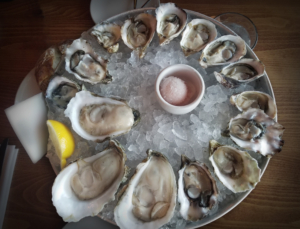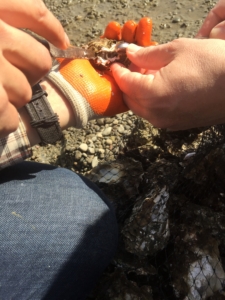How Oysters are Shipped Makes All the Difference in Seafood Safety
Have you ever thought about how an oyster gets to your plate? Consumers often only see the name of the farm and the restaurant where they are eating, but not all the steps in between.

(Credit: Bobbi Hudson, PSI)
Researchers at the Johns Hopkins Center for a Livable Future (CLF) in the Bloomberg School of Public Health’s Department of Environmental Health and Engineering, the Virginia Tech Seafood Agricultural Research and Extension Center (AREC), and the Pacific Shellfish Institute led a series of studies examining the performance of the oyster cold chain — the temperature-controlled supply chain all perishable foods undergo to get from farm to plate — and how they maintain food quality and safety across seasons, regions, and transportation modes. The research was funded by the National Oceanic and Atmospheric Administration (NOAA).
Tracking oysters
Oysters used to be considered a seasonal treat, but demand for oysters has grown in recent years and they’re now produced and eaten year-round. Dave Love, the associate scientist of CLF’s Seafood, Public Health & Food Systems Project, says that ensuring oysters that are safe to eat boils down to two key components – time and temperature.

Putting a temperature sensor in an oyster (Credit: Dave Love)
To collect time and temperature data, researchers visited oyster farms across the United States, from the Chesapeake Bay to Washington state. “We arrived just as the sun was starting to creep over the horizon and worked with oyster farmers at the farm,” Love shared. They placed nickel-sized temperature sensors inside a freshly harvested oyster and the box it was being shipped in. Overall, they worked with 140 businesses and tracked about 90 boxes.
“We watched them crisscross the whole country by truck and by airplane, and when the oysters reached the final customer, we had the restaurants and retail owners send the sensors back to us,” explained Love. The safe temperature threshold for oysters is 50°F and they found that nearly 1 in 5 boxes exceeded that temperature. Exceeding the temperature threshold puts oysters at risk for developing spoilage bacteria and/or Vibrio bacteria, a risk to human health and safety.
So, are your oysters safe to eat?
Oyster supply chains are generally safe, but Love pointed out some weak links in the cold chain, such as transitions between companies and initially cooling the product. There are ways to solve these problems though, such as also using ice to chill oysters in addition to refrigeration. He explained that, “if you imagine stacked pallets of oysters, the middle pallet is going to take a longer time to cool. Using ice in addition to refrigeration would initially cool the oysters down a lot quicker.”

(Credit: Dave Love)
Love also recommends using temperature sensors to track temperature. “The sensors can be as cheap as a few dollars, and the cost of a problem is a lot more,” he said. Study team member Bob Lane at AREC also produced an extension report specifically about temperature sensors. Having a practiced recall system in place would also help companies prepare for a situation where a recall may need to happen.
To ensure you’re getting the freshest oysters possible, Love recommends that consumers ask about the oyster and be straightforward. “Don’t hesitate to ask when the oyster was harvested, the origin, and if it is the freshest oyster they have.”
